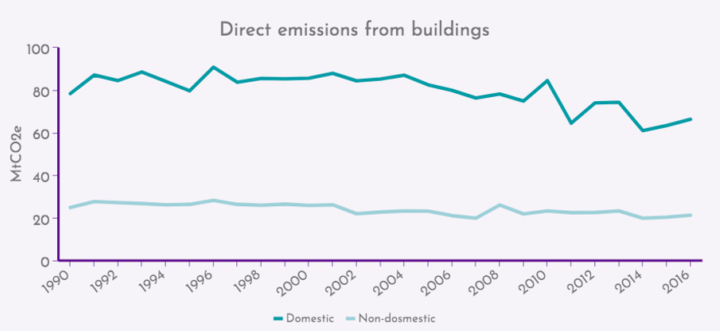Decarbonising heat: the basics
What does the term 'heat decarbonisation' mean and what are the UK's options for reducing emissions from heating our homes?

By Jess Ralston
@jessralston2Share
Last updated:
The International Energy Agency (IEA) estimate that globally, around half of all energy consumption is used for providing heat, mainly for homes and industry. In the UK, energy used for domestic heating and hot water accounts for around 15% of national greenhouse gas emissions.
Adjusting for annual temperature variations, estimated emissions from buildings in 2019 were just 13.5% lower than in 1990. This rate is not compatible with the Government’s commitment to reach net zero emissions by 2050.
Two key reasons why emissions have fallen so little are the country’s relatively old and inefficient housing stock – over a third of homes were built before the Second World War – and that new homes continue to be heated by fossil fuels; since 1990 around 10 million homes have been connected to the gas grid.

The Government will not meet its net zero target without tackling emissions from heating. Achieving this will require new homes to be designed and constructed to use clean heat, and that heating systems in existing properties are switched to low carbon alternatives.
The Government recently confirmed regulations for new homes - the Future Homes Standard – will be brought in from 2025. It will mandate low carbon heating in new homes from 2025 as well as higher levels of efficiency.
For existing properties, heating systems will need to be changed. There are approximately two ‘replacement cycles’ between now and 2050 – a gas boiler generally lasts for 15 years – during which systems that run on electricity and/or low carbon gas(es) can be installed. This natural churn means that there is little danger of boilers being ‘ripped out’.
At the moment, the exact mix of technologies needed to decarbonise heating is uncertain, but electrification looks likely to account for a significant proportion of progress as it is a proven technology in other European countries. In the ‘Balanced Pathway’ to net zero by 2050, the Climate Change Committee (CCC) model that the heat mix in 2050 is 52% electric heat pumps, 42% district heat, 5% hydrogen boilers and around 1% new direct electric heating.
However, some – like the oil and gas industry – argue that low carbon gases such as hydrogen could play a larger role than this. Mainly this is because hydrogen may be less disruptive to households than electrification as only the boiler or parts of the boiler will need to be changed whereas a heat pump could require changes to radiators too.
It is also likely that additional heating technologies, like heat networks (sometimes called district heating) and bioenergy will be required to make sure that all homes and buildings can be decarbonised.
Options for decarbonising heating
Electrification
The theory is simple – use renewable electricity to generate heat in the home. As power sector emissions fall, emissions associated with electric heating are decreasing rapidly.
Electric heating technologies are available to buy now, however, because the costs of electricity are currently higher than for gas, electrification could be an expensive option without policies to balance costs between fuels [link to blog]. High purchase prices are also a barrier, although these will fall as technology develops. In addition, in some properties electric heating such as heat pumps will require upgrades to energy efficiency (like the fitting of insulation) and possibly installation of larger radiators which could be disruptive to the household.
Low carbon gases
Again, the theory is simple - replace the natural gas that most homes use for heating with hydrogen, which releases energy but not carbon dioxide, the only waste product is water. Biomethane is also an option as it produces less carbon than natural gas over a full lifecycle.
For hydrogen to work, the pipes in the national gas grid would need to be replaced and home boilers would need to be adapted or changed. This is possible but could incur considerable cost. The benefit to this technology is that it requires very little behavioural change on the part of the homeowner – the heating system would operate in a very similar way as gas, and there would only need to be changes to the boiler at the point of switch (replacement or changing/addition of a few parts). There’s more on hydrogen for heating in this ECIU briefing.
Biomethane is chemically identical to methane from natural gas, so is suited to existing infrastructure and appliances. It is unlikely, however, that it can be produced in sufficient quantities to replace fossil gas entirely.
Hybrids
A hybrid system combining both electrification and hydrogen is a third option. Here, heat pumps could be used to meet the majority of heat demand, with a (low carbon) gas boiler taking over in extremely cold weather. Advantages of this approach include helping establish a market for heat pumps while hydrogen is developed to displace natural gas in the hybrid system eventually, and the ability to call on hydrogen when heat demand is at its very highest.
Heat networks
Heat networks connect a central heat source to a number of buildings via a series of underground hot water pipes, and are popular in countries such as Denmark, where heat networks supply 63% of households. The Government expects the heat networks market in the UK to grow quickly to supply up to 20% of heat demand over the next decade or so, investing £320 million into its flagship Heat Networks Investment Project to help get this underway.
Heat networks work particularly well in built-up urban areas or industrial clusters where there is a large and concentrated demand for heat. Over time, it is thought that if the central heat source can be low carbon, then there is the opportunity to ensure that multiple homes and buildings are decarbonised at once.
Biomass
Biomass can be used to reduce emissions when used instead of more polluting fuels like oil in off gas grid properties. Support for biomass boilers has been available since 2011 via the Renewable Heat Incentive (RHI), but take-up has been low.
Supply constraints also restrict the role that biomass – burning solid material such as wood – can play. In any case, according to the Committee on Climate Change, this resource may be better used in other sectors of the economy such as construction, where it provides carbon storage without the need for CCS and reduces demand for carbon-intensive materials such as steel and cement.
Cost
All these options will likely be more expensive than simply maintaining the current, natural gas-based heating system. However, factoring in economic growth, the National Infrastructure Commission states that total costs of heating will represent a smaller share of GDP in 2050 than today.
| Technology | Cumulative additional cost to 2050 (£ billion) | Annual cost in 2050 (£ billion) | Emissions under new system (MtCO2) |
|---|---|---|---|
Electrification (heat pumps) | 270 | 40 | 5-10 |
Electrification (direct) | 190 | 38 | 10-15 |
Hybrid | 180 (no green gas), 210 (with green gas) | 40 | 20-25 (no green gas), 15-20 (with green gas) |
Hydrogen | 130 | 36 | 20-25 |
Another study modelling zero emissions also found the annual cost for electrification and a hybrid system to be very similar, but the cost of hydrogen about 30% higher, reflecting the costs of producing the gas via electrolysis. This shows that it is currently quite unclear about which option will be the cheapest and easiest.
Policy
Given the similarities in running costs, the Government sees both electrification and low carbon gases as genuine, viable options for home heating systems compatible with its net-zero emissions target. Experts agree that heat networks and biomass will likely play some role in the energy transition.
The Government is expected to decide which technology to employ by 2025, when heat decarbonisation will need to be underway to meet net zero. As part of its Ten Point Plan, government set a goal to install 600,000 heat pumps per year by 2028, although there is currently no policy in place to achieve this target.
The choices and immediate actions from Government are expected to be outlined in 2021, when the Heat and Buildings Decarbonisation Strategy is due for release.
In the meantime, it plans to continue trialling both systems at scale and assessing the results. In 2020, the Clean Heat Grant and Green Homes Grant were announced, both of which support heat pump uptake. The Green Homes Grant had over 100,000 applications in the first few months of the scheme, with around 17% for low carbon heating measures. The continuation of this scheme and addition of the Clean Heat Grant are likely to further build public awareness and demand for alternative, low carbon heating systems.
The Clean Heat Grant is due to replace the RHI in 2022. The RHI pays owners of renewable heating systems like heat pumps incremental sums over 7 years to help cover the initial cost. The new Clean Heat Grant will instead be an upfront grant (up to £4,000) issued to someone buying a renewable heating system, making low carbon heat more accessible.
In the shorter term, the Green Homes Grant provides up to £5,000 (or up to £10,000 for fuel poor households) for improving the energy efficiency or decarbonising the heating system within homes. This scheme will run until March 2022.
It seems likely that a combination of heating technology options will be needed for the UK’s heterogeneous building stock to decarbonise, with the pathway that offers the best heating performance, lowest greenhouse gas emissions and the lowest cost likely to be the ultimate choice.